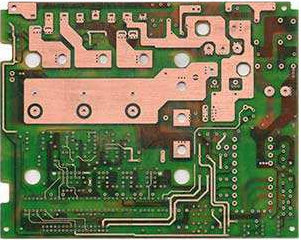The following is an introduction to various failure probabilities and countermeasures of PCB capacitors:
Understand the probability of various failures, clarify the order of maintenance work, understand the key points of maintenance, improve efficiency, save man-hours, and quickly locate fault points.
According to the actual PCB maintenance statistics, the probability of damage to the electrical part of the equipment is: failures caused by component damage account for one-third of the total failures, and failures caused by circuit board disconnection or corrosion account for one-third. Failures caused by program damage or parameter adjustment accounted for one third.

Generally speaking, components with high current and components with high voltage are the first ones to be easily damaged, such as the fuse, rectifier bridge, switching tube in the switching power supply, IGBT in the frequency converter, driving optocoupler, and the components in the PLC. Output transistors, various fuse resistors with relatively large power, current limiting resistors, etc. These can be quickly checked online using the multimeter's continuity test, resistance test, and diode test gear.
Nodes connected to external terminals are easily damaged, such as PLC input and output circuit, current detection circuit interface circuit, 485 communication interface, etc. Because these parts are connected to transmission lines, they are more vulnerable to terminals. It is more susceptible to external shock and interference due to the influence of plugging and disassembly. It is also possible to roughly judge whether the circuit is damaged by testing the resistance value of each point to the common terminal.
Excluding the components with high current and high voltage and the components at the interface, in the common low-voltage DC circuit system, the probability of PCB component damage in descending order is: aluminum electrolytic capacitors, resistors, optocouplers, ceramic capacitors, relays, Zener tubes, transistors, tantalum capacitors, operational amplifiers, logic chips and processor chips.
Aluminum electrolytic capacitors are components that are bound to be damaged by aging. Its damage is only a matter of time. Moreover, it is common for faulty capacitors to range from 1 to 330μF. Therefore, the inspection should focus on such electrolytic capacitors that have been used for a certain year.
Ordinary multimeters and capacitance meters with capacitance test gear can test the capacitance, but the capacitance does not decrease does not mean that the capacitance is not damaged. The quality of the capacitance needs to be proved by other parameters. In addition to the capacity of the capacitor, we can also use the digital bridge to test the loss of the capacitor, that is, the D value. Compared with the D value range of the normal capacitor, the D value deviation is too large, indicating that the capacitor is aging and needs to be replaced.
The VI curve tester is also a good tool for judging the quality of capacitors. The standard VI curve of the capacitor should be a standard ellipse centered on the origin and symmetrical on both the horizontal and vertical axes. If the curve is skewed, it means that the capacitor ESR is too large and has been aging.
The resistance is most common in the form of an open circuit or a larger resistance value. You can compare whether the resistance value exceeds the nominal resistance value through online testing to judge whether the resistance is good or bad.
The damage of the optocoupler is the most common in the driving type, and it can also be judged by online simulation.
The damage of the ceramic capacitor is manifested as a short circuit or a slight leakage. The open circuit situation is seen in the ceramic capacitor of the SMD package, because the pin is corroded and opened. Slight leakage cannot be detected in most cases. You can remove the suspected capacitor, measure its capacitance with a capacitance meter, and then replace it with a capacitor of the same capacity, let the PCB board actually work, and observe whether the fault disappears. Analog circuits often include some small ceramic capacitors for feedback filtering. If these capacitors have a slight leakage, they may change the circuit parameters and cause the circuit to work abnormally. If no obvious abnormalities are found after checking the various PCB components, you can Try replacing those small ceramic capacitors.
The damage of the relay shows that the contacts are affected by sparks and oxidized, resulting in poor contact or completely inaccessible, and the contacts are burned to death by the welding effect of high current and cannot be released. You can judge whether the contact is good or bad by powering up the relay coil and measuring the contact resistance of the contact.
Since the Zener diode needs to adjust its own current consumption to stabilize the voltage, when there is a chance to pass a larger current, it may cause damage. In addition, the damage of the TVS (transient voltage suppressor) in the circuit is also the case.